Chickasaw Plum: First Springtime Blossom
Every spring, three wild plums put on a show locally: The Chickasaw, the Flatwood, and the American. They burst out in white blossoms and no leaves.
When in naked bloom they look similar but that’s where the resemblance stops. The Chickasaw and the American go on to produce consistently edible plums whereas the Flatwood’s fruit can range from extremely bitter to sweet. Telling these plums apart before they fruit is a bit of a guessing game.
If you have skinny leaves it is either the Chickasaw or Flatwood. If the tips of the teeth on the leaves have yellow or red glands (you’ll need a hand lens) it is the Chickasaw, otherwise the Flatwood. If you have fat leaves with a strong pointed tip, it’s the American though it is not common here. Locally the fruit of the Chickasaw (Prunus angustifolia) ripens to a sweet red in the spring and is gone by early July. It often forms a thicket.
The Flatwood (Prunus umbellata) which often stands alone, ripens to black or yellow and can be around through the summer into the fall. The American (Prunus americana) tends to fruit in late summer to early fall and has red fruit. The fruit of the Flatwood often remains amazingly bitter and hard even after months on the tree. Settlers used it to make jellies or fed it to livestock, hence its other common name, Hog Plum though there are several “hog” plums. Native Americans and settlers, however, regularly ate of the American and Chickasaw plums, the latter developing very sweet fruit with a tang. The first foragers used the plums fresh and dried for winter use. Some tribes took out the seed kernels, others didn’t. Let’s talk about that.
Liberated from their shells the sunflower-sized kernels of these plums can create cyanide in your gut. Very small amounts don’t bother us but we are not talking about small amounts. Natives would make cakes out of the kernel mash. Letting the cakes set for a day or so allowed enzymes to work on those chemicals as did subsequent cooking, making the cake edible… or at least that is the explanation experts give. That strikes me as a lot of work for such a small amount of food that’s potentially toxic. That said they could have been a treat, a flavoring, an essential macro nutriment — oil — to make them worthwhile or a micro-nutriment. Calories are not the only reason to forage.
In the 1800’s there was great interest in making cultivars out of native plums and by 1901 there were over 300 of them. But mechanization of fruit production in the early 1900’s led growers away from the native varieties though there has been some interest of late to use the native plums again as a high-value specialty crop.
Besides man the Chickasaw Plum’s fruit is eaten by deer, bear, fox and raccoon. The thorny thicket is valuable for songbird and game bird nesting including the bobwhite and mockingbird. It also makes a good wind break and can be used for erosion control. The plum, extensively used, was taken everywhere by the Chickasaw Indians and it has many local names. While usable, the Flatwood Plum, is not prime foraging food. Its quality can vary from tree to tree, rarely rising to the gustatory level of the Chickasaw Plum. The American Plum was also used by the natives.
The Chickasaw Plum is one of my favorite trail and yard nibbles. As to its botanical name Prunus angustifolia. Prunus (PROO-nus ) is the Roman name for the plum. Angustifolia (an-gus-tee-FOH-lee-uh) means skinny leaf (see photo directly above.) Umbellata (um-bell-LAY-ta) means like an umbrella for its shape. Americana (ah-mare-ree-KAY-na) means American. “Chickasaw” is Choctaw for “old” and “reside” or as we might say in English, “the old place.” Incidentally, the Chickasaw Plum is native to Texas and Oklahoma but is naturalized through much of the United States where there are sufficient winter chill hours, such as central Florida north.
The Chickasaw plum and the American plum are closely related and hybridize easily. That means… yep, you guessed it. You can find plums in the wild which display some characteristics of each and can be impossible to identify.
Green Deane’s “Itemized” Plant Profile
IDENTIFICATION: Chickasaw Plum: Small thorny tree to 25 feet, usually much smaller, flower small, under half an inch, 5 white petals, fragrant; reddish orange anthers, appear in clumps in early spring before the leaves, fruit bright yellow to red, round to oval, 1/3 to 1/2 inch in diameter, flesh juicy small plum, bark first smooth and reddish then with numerous elongated light horizontal hash marks. The leaf has a center troth. The teeth have yellow or red glands on the tip. Some times the fruit can stay green yet ripens to sweet.
TIME OF YEAR: Late spring in Florida, late summer farther north, usually around September. Locally the Chickasaw Plum is done fruiting long before the 4th of July. The Flatwood Plum can have fruit persisting into the fall.
ENVIRONMENT: The Chickasaw forms thickets in open areas, any open space in scrub forest, sandy soil, roadsides, fences, prairies, Pennsylvania west to the Rockies, south south to Central Florida, also California. Easily transplanted or grown from seed. It requires some chilling so won’t grow in South Florida and similar climates. The Flatwood is often a stand alone.
METHOD OF PREPARATION: Chickasaw: Cherry-size plum, out of hand or for jelly, pies, preserves and wine. It makes a tart, bright red jelly. The Flatwood was used to make jellies or to add to other jellies. It is usually too sour and hard to eat out of hand.

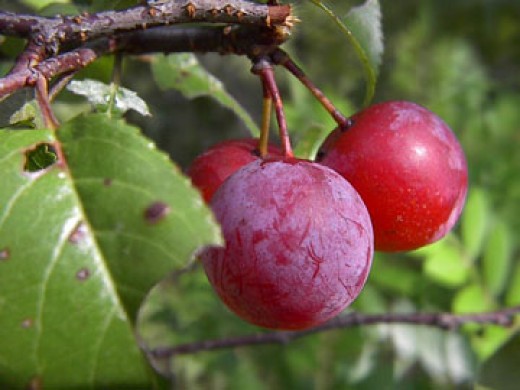
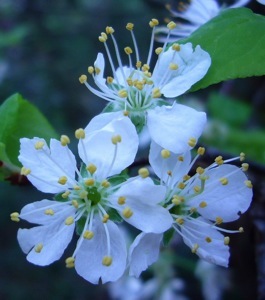
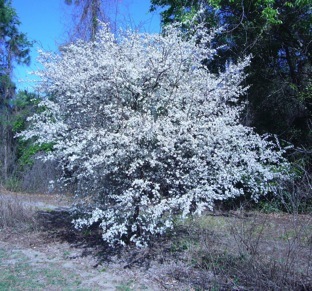
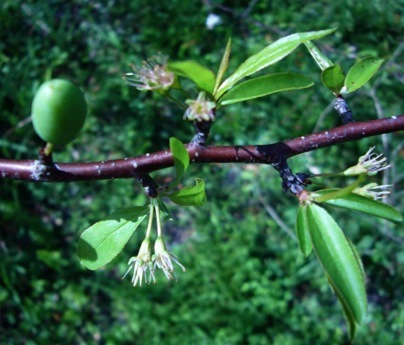
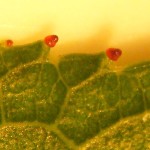

Thanks for the info. So it is just the pit that is poisonous! I am relieved. I ate some chickasaw plums growing near our house and then developed extremely severe heart attack symptoms. Later I read somewhere that the plums were poisonous. At least now I know it wasn’t true–my symptoms weren’t the fault of the plums.
The kernel inside a Chickasaw plum seed is about the size of a sunflower. It is doubtful one would notice anything from eating just one kernel. The natives would collect the kernels, mash them, let them set for a few days, then bake them into small cakes.
Do you have to have two chickasaw plum trees for fruit production?
I’m sorry. I don’t understand the question. If you mean do I sell fruit trees, no I do not. If you mean what do I have growing in my yard, I have a large Chickasaw plum.
I guess he was asking if the are self pollinating or not?
Chicasaw plums don’t seem to require a second bush to bear fruit. There does not seem to be a self-polination barrier as is true in some species.
Incidentally, through Columbia, South Carolina, where I live is an old indian trial, now called Two Notch Road (and is now also US 1). There are many places along this road to find chicasaw plums, presumably they were planted centuries ago as a forage item along the trail, or in areas that were inhabited for a time.
i would like to have two seedlings of chickasaw wild plum, is it possible to buy them from you? please respond to email. thank you jean
Hi Green Deane – I just found your website, and looks like I’ll be back…to explore. Lots of very valuable info for me!!!
My husband and I purchased a 19 acre site in GA to retire to; wooded with cabin and small clearing. I’m thinking of planting some chickasaw plums…around the borders and I can get them pretty cheap. Are they good producers? I’m a canner and have already started an orchard in the clearing, but would like some carefree fruit that I don’t need to spray.
Can you tell me where I can order Chickasaw Plum Tree Seeds? Thank you.
B&T Seeds might have them. But th easiest thing to do is ask someone to send you some seeds in the spring after they have dropped.
I think Cameron was actually asking if plums are self fertilizing or if you have to have a male and female tree to grow fruit.
They are self-fertilizing.
Not until I got a second Chickasaw did the flowers mature into fruits. The trees are not male & female with only the female producing fruit(as in Holly or Pygmy Fringe), but they require cross-pollination between 2 separate but close by trees.
I was gifted a chickasaw plum tree when people were thinning there thicket out. From the very first year I have had plums and many MANY saplings sprouting over the yard. Last year I saw it covered with hummingbirds. Such a pretty sight… I didn’t need a second tree. My husband took down the original tree and I have one sapling in the front sure to have many more soon! 🙂
I bought two chickasaw trees about 11 years ago. I got fruit (or more precisely fruitlets that most years are completely wiped out by late freezes in my location) initially, but then one of my trees died back to the ground, and after that my tree hardly set any fruit at all, probably less than 1/10 of 1% of the fruit set I was getting before. So it seems to me that chickasaw plums do require cross-pollination. I wonder if the people that are getting good fruit set from just one tree are getting cross-pollination from wild trees in their areas that they may or may not know about.
Nice post by the way. I planted a couple Chickesaw plumbs and was curious how good they are for eating. Most sources sly mention they are good wildlife fruit or maybe good for jam. I am hoping they are good raw right from the tree.
I eaten the ripe ones off the tree for years. To me they taste as good as any purchased plum.
Upon seeing my chickasaw plum tree my eldest brother expressed his happiness! He hadn’t seen one in years and said the fruit was wonderful! He is correct very sweet if picked when red or if you try to beat the birds to them they could be bitter. Jam is very good made from these and wine. The enzymes in the seed break down that toxic property mentioned if made into a mash and left to do the job.
I have both yellow and red. The red are somewhat bitter, and the yellow are great, but both are edible right from the tree. The roots grow similar to blueberries in that they typically stay just below the surface of the ground and grow horizontally. Many new trees will grow from that horizontal root. If transplanted they usually require a little attention the first year, but after the first year they will probably survive with no attention.
Quanloi75. Are you located in Texas? If so do you have plums available that we could come and pick to make jelly for friends and family? Thanks, Carolyn (Dallas)
Just wanted to say that the American plum is also delicious if you get it when it is fully ripe. You should generally avoid eating the skin though since it is full of tanin and pectin, and is fairly astringent. But the flesh is delicious. I’ve picked gallons of these and made jams jellies and a sort of plum-pop. They were all very good (although again try to keep the skins out as much as possible). The pop included the skins and was initially very bitter, we discovered though that the bitterness could be reduced drastically by adding a small amount of gelatin powder to the batch as it cools.
Mail Order Natives in Florida sell 3 different Chickasaw plum cultivars. Prices are inexpensive & the quality of the trees, service, & shipping is awesome.
When grown from seed, how many years till the tree produces fruit?
Three or four.
I live in Central Texas where the Mexican Plums are common. However, I remember that the Chickasaw fruit in SW Missouri is sweeter and more red. Both fruits are about the same size and make great jam. But, only the Chickasaw can be eaten straight off the tree. I got some Chickasaw cuttings from my sister in the area just east of Dallas. They have been potted now for a month and most are leafing out now. It looks like cuttings are the way to go. I recommend:
1. Small branches no larger than a pencil in diameter
2. Short pieces no longer than 8 inches below ground and 12 inches above ground after potted
3. Score the bark with a sharp knife along the area length to be potted below ground level. These will serve as areas for absorption of moisture and starting points for roots
4. Dip the trimmed, scored portion of the cutting in a liquid solution of root stimulator before potting.
5. Use at least one gallon pots so as to keep plenty of moisture in the soil until rooted
6. Water every day to keep the soil muddy wet until roots are established – about 2 months. I find that catch trays under the pots help maintain plenty of moisture.
Do you have plums that we could pick? And where are you located in Central Texas if they are available to pick. Thanks, Carolyn
I live near the in san jose california and just wondering if chickasaw plums are growing in my back yard. There are two thickets and one produces what looks like dull skinned cherries but another thicket a few feet from it makes a very slightly larger fruit that looks similar but grows on one stem not joined stems like cherries. The fruit on the first thicket I described has joined stems and looks like cherries except the skin is dull like a plum. Do these wild trees in my backyard seem like chickasaw plums?
I think there’s a huge patch of these at the La Chula trail at Paynes Prarie. I recall some bare thorny trees with flowers there earlier this year.
I am in search of the wild plums to pick this year. We are aware of where they are growing in Okla – 6 hrs North of Dallas. We would like to pick them closer to Dallas. Please email me or post on the blog if you have them on your land available to pick, or have seen them along the roads or highways in North, North East, East or West Texas and reasonable driving distance from Dallas. Thanks, Carolyn
carolynhicks1950@gmail.com.
Grew up in Oklahoma with lots of relatives in Kansas. Pretty sure these are what we call Sand Plums. My mom and I pick them wild and turn them into really yummy jam and jelly. Mom picked them with her grandma growing up in Kansas. We have friends who use them for wine, but I’ve never tried it. I live in Colorado now and have been on the lookout for wild plums. No luck yet. Love yourwebsite. I’m on my second batch of Cider, Hard, but fast and easy! Love it!
There is a difference in the plums. The kansas forestry department sells 3 varieties. Chickasaw, American and sand. In 2017 they were selling 25 seedlings with good root systems 25 of them for 20 dollars. At the time of this writing I had mine ordered and delivered last week and planted yesterday. They were healthy and well packaged.
Several years ago a neighbor who has since moved away gave me some plums from her Chickasaw plum tree. I planted one of the seeds. A beautiful healthy looking tree grew up but it has never flowered – so disappointing. Its location is shaded in the morning but I think it gets plenty of sun in the afternoon. Do you think it would be a wasted effort to root a cutting to plant in another spot?
I think it would be a good idea.
i love this it really helped me with my chickasaw report <3
How many years does it take to start producing fruit?
Very few, two or three.
I grew up eating wild plums, both yellow and red. Just bought two small trees of yellow that I hope will colonize in my backyard. My yard is mostly clay, though.
Pea, I just bought a 26 acre property in Central Missouri and all the soil here is clay. I had a Forrester take a look at my woods a couple of weeks ago and she identified 3 wild plum trees. They were blooming at the time, so they should produce. I would say your soil is going to be ok.
i found where you can purchase chicksaw plum tree at 1-888-210-6750, the nursery is nature hills nursery located in various places including Alabama.
Interesting… I just planted the seeds from the plums I ate.
Texas has Mexican plum trees and I don’t know what the small trees that are native to Fort Worth area. Doesn’t get to around 5 feet tall and people use them for jelly.
here in north central texas ….on the Red River…we have the “sand plumbs” or “cherry plumb”..small bush grows all along the road sides…sweet and early summer harvest…..but also have the Chockta or “hog” plumb…they grow like a standard fruit tree and have a dark fruit that is bitter ’till it falls from the tree….then is sweet flesh with tart skins…much like a precimon..that is about the ripeness……everyone has different names but I think everyone is talking of the same trees….hope the “hog” plums will make an o.k. wine….”cherry” plumbs probably better but missed the window on them…….
Enjoyed the info on the Chickasaw plum. My wife made a small batch of jam for me 3 yrs ago from a neighbors tree. It was the best jam I have ever eaten. The problem, the tree hasn’t produced for the past two years and I have been on a quest to find another tree. No luck with that. I would pay to find more. Please advise.
Me too! I love to make plum jam!
I grew up in Miami but my parents had 5 lots along a clay road on the National Forest side of Ocala. 4 of the lots had been “field” and my parents planted pine seedlings for the future and to enjoy the land for camping.
The “backlot” that ended against someone’s very wooded property was full of what I now know where Chicasaw Plums.
My mom would come up from Miami to pick the plums and make jelly every year for a very long time.
However, that was 30 years ago and to this day I think of it as the best jelly in the world (!!)
Maybe once or twice a decade I’ve been able to find some jelly here and there, like at the annual Klumquat festival…
But it’s been 4 years now – and I WISH I knew some one who made it/sold it. Or could tell me where I could drive to get them. Ironically I am moving back to Miami this month after 30 + years of being away.
And NOW just like my mom, I would drive up all the way from Miami to get them ..
I should call them the Rapunzel Plum LOL
@Madelinever
I’m going to start a bnb at what was my grandmother’s house in Miami – so I should be able to be reached at http://www.My3Abuelitas.Miami
#YumPlum
That was a typo – should be @MadelineHere
And @My3Abuelitas on twitter etc.
Thanks for all the info!
It’s pretty validating that I’m not just some nut saying “theyre super tiny plums, nothing like plums, but the are, and they make the best jelly in the world!”
Its not just nostalgic childhood ideas!!
#wild plum jelly
I wa wondering if anyone has heard of a “Potawatomi ” plum?
I would like to buy some Chickasaw plums please tell me how to go about it a email address or phone number thank you
May find a great price at legg creek online. Right now they have a great price for them and also sell alot of other fruits. I’ve done business with them starting my own med. Size orchard and they are great!
Most states have a forestry department which hold sales of the most affordable seedlings I have ever seen. The forestry department offers plants that are indigenous to your area and would require very little care as such. Check there for the wild plums that would do best in your area. Some form of wild plums grow over much of north america be it the Chickasaw, American, or sand plum, I have not found the differences in the plums to be so significant as to favor one above the other.
The front of my property has a long thicket of either Chickasaw or Am. Wild plums. They are way too thick in areas. Pretty much impenetrable, except by the coyotes, which are a problem here. Only a few of the trees bear fruit, although it seems most or all bloom. The trees were here when I moved here 9 yrs. ago. Should I tag the ones that bear and get rid of the others, or do I need to leave some of the non-bloomers for pollination?
Non-bloomers wouldn’t help pollinate anything.
But maybe they bloom but aren’t setting out fruit? Is that what you mean?
I don’t know but to me in the wild they like creating like grooves, or tree gatherings in South Florida we call “hammocks.”
These spindly twisted trees always strike me as “flocking” or even more so “dancing” together.
Like they are just frozen in their interlocking gestures while your not looking..
So I’m thinking the more, the merrier.
@MadelineHere
I live in Ocala – planted Chickasaw Plum in 2015 – no flowers yet. Tree was a few years old when I got it from nursery. I have given it large dose of fertilizer in Jan . . . why won’t it bloom? All the wild trees are already blooming.
Should be soon
Katy Brown, probably you should not have fertilized. I have never fertilized mine, and it bears a lot of fruit.
My grandmother grew a Chickasaw Plum thicket at her home on a low ridge in Rayville, Louisiana, during my childhood years in the 50’s-70’s. The small shrub-like trees were covered in green oblong fruit which little worms loved to invade as they ripened, causing some of the fruit to redden and fall prematurely. When no one was looking I’d crawl under the trees, collect a few, and nibble around the worm. But I got to help pick when the fruit was red, round, soft, and ripe, with a little bluish blush. Skins remained tart, but flesh very sweet and so juicy, almost impossible not to dribble onto clothing. She made plum jelly every year, and it was the most beautiful, best-tasting jelly I’ve ever eaten. I have finally figured out which of the “wild plums” that must have been, and last year we ordered 3 ‘Guthrie’ Chickasaw Plums and got them into the ground. It’s supposed to be a yellow version of my grandmother’s red plum. But I’d still love to have the red one, too, if anyone knows where to get one. So very sorry I didn’t save a seed or two from her plum thicket. It probably lived for 40 years or more, till finally succumbing to borers. And old age….. 🙂
They do not require two trees. I have only one, in the city, with no other trees for miles around, and mine has always borne lots of fruit. My mom has several trees, and hers always fail to bear.
I have plenty of Chickasaw plum trees if someone would like to come get a few in Rocky Branch TX just email me.
Hi Angela,
It’s probably too hot right now, however I am searching for a couple more healthy Chickasaw Plum trees. Do you mind if I ask about the size and flavor of your trees’ plums? If they are tasty, I would be happy to drive out from Dallas this fall and buy a couple.
Thank you!
Hi there, I have one flatwood and one Chickasaw. The Chickasaw blooms every year but no fruit. The Flatwood did not bloom but I planted it less than a year ago. What would prevent fruiting and blooming? Thanks!
Approximately eight years ago, I purchased and planted a Flatwoods plum from a native plant nursery in Florida. I chose this variety since I didn’t want the suckering problems associated with the Chickasaw plum. My tree is a beautiful, healthy tree, in full sun and blooms every year. It has never set fruit though. I just checked the web to see if it is supposed to be self-pollinating, and learned that it is. I see others have had the same problem. Any ideas?
Son gave me a Chickasaw plum to plant 10 yrs ago. The “bush” is 10 ft tall and very bushy. It is planted in full sun but has NEVER born a plum. Very disappointed.
In Gage, Oklahoma (near where the Texas panhandle nudges into the Oklahoma panhandle) my great aunt made the most delicious plum jelly, a beautiful red color. She referred to the fruit as Sandhill plums. They often grew along barbed wire fence rows. Planted by birds? Is Sandhill plums a local name for Chickasaw Plums?
Hi Deane, is there any chance you can point me to any primary source materials for “natives would make cakes out of the kernel mash”? Much appreciated! -Erica
We bought our property in 2017, and I discovered last year that the very back is covered by a Chickasaw Plum grove. The trees appear to be healthy; they’re covered in beautiful white flowers in the spring. Once I figured out what they were, I went back out to look for fruit. Not one of the many trees had a single piece of fruit on it. It wasn’t because birds and animals ate them; I looked for fruit not long after the flowers were gone and leaves were sprouting. There should’ve been tiny fruits all over the trees. The trees do not appear to have any disease or insect infestation; they’re putting out suckers and seem very happy and healthy. I assume the sandy soil is fine, since the trees are flourishing. Does anyone know why the plum trees would be covered in flowers and not set any fruit? I assume a late freeze would cause the problem, but are there other reasons? I’m wondering if there’s something I can do to ensure fruiting. Thanks for any help!